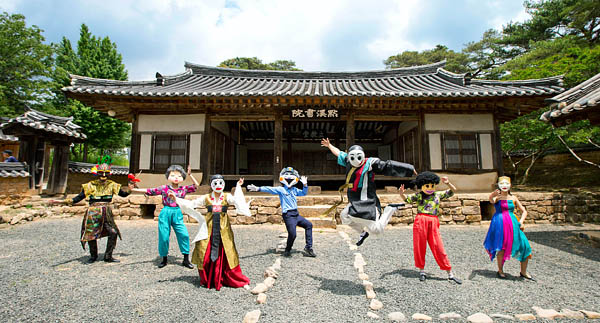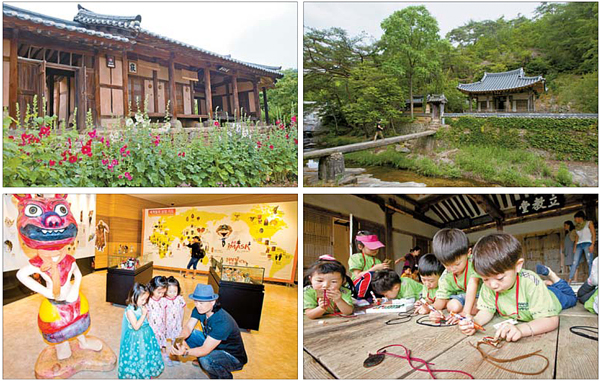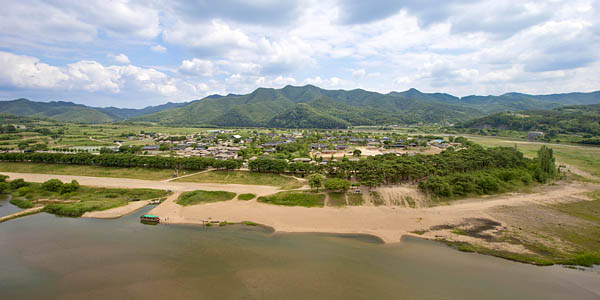In Andong, new spins on ancient culture

The “Hi Mask” performance, in which dancers wear international masks, has been drawing families with children to Andong, North Gyeongsang. Visitors can see the dancers at the Mukgye Seowon (in the background) or at Confucian Land. [LIM HYUN-DONG]
In the city, where 317 cultural assets - 92 state-designated and 225 province-designated cultural properties - exist, people can easily experience traditional Korean culture.
For those who think traditional culture is boring, numerous new activities will likely make the cultural experience more interesting. One of the most recognized activities is the fusion talchum (traditional mask dance) show “Hi Mask,” a nonverbal performance in which several people wear international masks.
Visitors can also spend the night at a traditional Korean house.

Clockwise from top left: The Sugok Historic House, where visitors can stay overnight; the Manhyujeong Garden, just a 20-minute walk from the Mukgye Seowon; children make necklaces shaped like masks at the Mukgye Seowon; an international mask exhibition at Confucian Land. [LIM HYUN-DONG]
There is a 300-year-old seowon, a traditional education center, in Gilan-myeon in Andong. The Mukgye Seowon, listed as Gyeongsangbuk-do Folklore Cultural Heritage No. 19, was constructed in 1687 to commemorate the scholarly achievements of Kim Gye-haeng, a government official from the early period of the Joseon Dynasty (1392-1910).
Many scholars studied at the Mukgye Seowon for generations. Although many tourists visit Hahoe Village, Mukgye Seowon is not as popular of a tourist attraction. It takes about an hour by car to reach the Mukgye Seowon from Hahoe Village, which was listed as a Unesco World Heritage Site in August 2010.
Recently, however, more people have been visiting the Mukgye Seowon despite the fact that there are not convenient facilities nearby.
Part of the reason is Gyoungbuk Frontier Culture Foundation’s efforts to hold events for families with children. Monthly events include learning to sing folk songs, making traditional masks and wearing traditional clothes.
The organization also encourages visitors to enjoy the beautiful landscape of the surrounding Manhyujeong Garden, listed as Gyeongsangbuk-do Cultural Heritage Material No. 173, which is situated in a valley near the seowon. Since the events began in March, reservations have been booked until December.
The “Hi Mask” show is one of the new activities. The nonverbal performance is unique in that performers wear different masks, each representing a different country. They include the Hahoe Mask (National Treasure No. 121) and Krampus of north and central Europe.
People wearing these international masks perform traditional dances, mixed with modern tastes. For instance, a person wearing the Korean Hahoe Mask dances with another person wearing a Japanese mask featuring a fox. Break-dancing is also part of the performance.
Talchum is Andong’s traditional cultural content and meaningful to the city. In fact, Andong is renowned for the Hahoe Mask and a ritual listed as National Intangible Cultural Heritage No. 69 called Hahoe Byeolsingut Talnori, or the Mask Dance Drama of Hahoe.
Andong also hosts the Andong International Mask Dance Festival every year in the fall. Several international mask performances are staged at this annual dance event. Last year, dancers of “Hi Mask” kicked off the show. Such events have been effective in attracting people back to the Confucian academy.
The Ministry of Culture, Sports and Tourism, Korea Creative Content Agency and the Gyoungbuk Frontier Culture Foundation worked on “Hi Mask,” spending about 600 million won ($510,000) to prepare for the performance.
Around the area, there are many other things to enjoy as well, such as magic shows at the nearby Confucian Land, where a mask exhibition displays some 200 masks ranging from the Hahoe Mask to superhero masks such as that of Iron Man.

Gail Village in North Gyeongsang is also growing in popularity, since it has added cultural components. The family of Andong Kwon lived in the town for about 500 years. The Sugok Historic House, listed as Important Folklore Cultural Heritage No. 176, is one place in this town where people can spend the night enjoying a traditional experience.
Built in 1792, the house includes many aspects of yangban (aristocratic) life in the Joseon Dynasty. The ancient site includes a main house, guesthouse and ancestral shrine.
The house has been empty since 1960, and the Gyoungbuk Frontier Culture Foundation has been utilizing the space for overnight experiences since 2010. Visitors can also learn folk painting, walk around the town and participate in a photo contest.
Once renovation of the inside of the house is complete, new events such as classic concerts and Hi Mask performances will be staged.
“I don’t want to leave cultural properties such as the Mukgye Seowon and Sugok Historic House empty,” the Gyoungbuk Frontier Culture Foundation’s executive director, Kwon Du-hyeon, said. “Instead, I want to revive them to become educational and cultural spaces.”
Applicants for the Sugok Historic House experience can stay two days and one night.
“Since the house is too big, it has been a long time since I moved out of the house,” said the owner of the Sugok Historic House, Kwon Dae-song. “Even if it is a cultural property, I believe the house looks more beautiful when people actually live in it. I am very thankful and proud of those people who come to experience spending a night here.”
In addition to the Sugok Historic House, there are a few other historic traditional houses in Gail Village, such as Gwon Seong-baek’s Historic House, listed as Important Folklore Cultural Heritage No. 202. Visitors can get a personal tour of the village from locals.
Gail Village is just a 10-minute car ride from Hahoe Village.

The view of Hahoe Village from Buyongdae, a cliff that overlooks the village. [LIM HYUN-DONG]
info
It takes three hours by car to reach Andong, North Gyeongsang, from Seoul City Hall. The “Hi Mask” performance at Confucian Land in Andong will run through July 24.
The performance starts at 11 a.m. and 2 p.m. every Sunday, and costs 12,000 won for adults and 8,000 won for children. There is no entrance fee for the mask exhibition inside the hall.
Reservations are required to spend a night at the Sugok Historic House and Mukgye Seowon. A single room costs 60,000 won to 120,000 won. To watch a “Hi Mask” performance or learn mask dances, at least 20 people need to make reservations.
For more information, contact the Gyoungbukontier Culture Foundation: 054-841-2433.











with the Korea JoongAng Daily
To write comments, please log in to one of the accounts.
Standards Board Policy (0/250자)